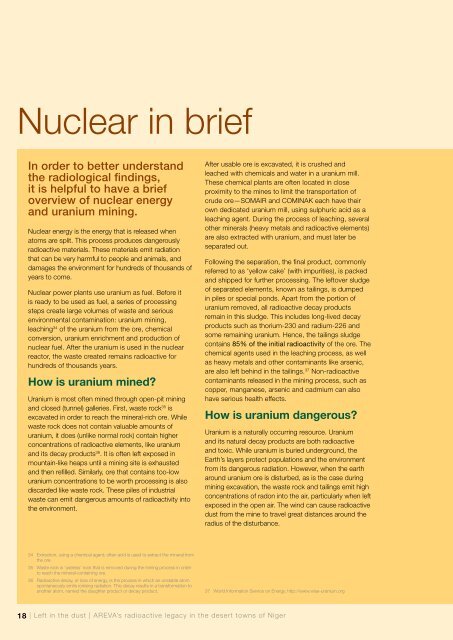Left in the dust - Greenpeace
Left in the dust - Greenpeace
Left in the dust - Greenpeace
Create successful ePaper yourself
Turn your PDF publications into a flip-book with our unique Google optimized e-Paper software.
Nuclear <strong>in</strong> brief<br />
In order to better understand<br />
<strong>the</strong> radiological f<strong>in</strong>d<strong>in</strong>gs,<br />
it is helpful to have a brief<br />
overview of nuclear energy<br />
and uranium m<strong>in</strong><strong>in</strong>g.<br />
Nuclear energy is <strong>the</strong> energy that is released when<br />
atoms are split. This process produces dangerously<br />
radioactive materials. These materials emit radiation<br />
that can be very harmful to people and animals, and<br />
damages <strong>the</strong> environment for hundreds of thousands of<br />
years to come.<br />
Nuclear power plants use uranium as fuel. Before it<br />
is ready to be used as fuel, a series of process<strong>in</strong>g<br />
steps create large volumes of waste and serious<br />
environmental contam<strong>in</strong>ation: uranium m<strong>in</strong><strong>in</strong>g,<br />
leach<strong>in</strong>g 34 of <strong>the</strong> uranium from <strong>the</strong> ore, chemical<br />
conversion, uranium enrichment and production of<br />
nuclear fuel. After <strong>the</strong> uranium is used <strong>in</strong> <strong>the</strong> nuclear<br />
reactor, <strong>the</strong> waste created rema<strong>in</strong>s radioactive for<br />
hundreds of thousands years.<br />
How is uranium m<strong>in</strong>ed?<br />
Uranium is most often m<strong>in</strong>ed through open-pit m<strong>in</strong><strong>in</strong>g<br />
and closed (tunnel) galleries. First, waste rock 35 is<br />
excavated <strong>in</strong> order to reach <strong>the</strong> m<strong>in</strong>eral-rich ore. While<br />
waste rock does not conta<strong>in</strong> valuable amounts of<br />
uranium, it does (unlike normal rock) conta<strong>in</strong> higher<br />
concentrations of radioactive elements, like uranium<br />
and its decay products 36 . It is often left exposed <strong>in</strong><br />
mounta<strong>in</strong>-like heaps until a m<strong>in</strong><strong>in</strong>g site is exhausted<br />
and <strong>the</strong>n refilled. Similarly, ore that conta<strong>in</strong>s too-low<br />
uranium concentrations to be worth process<strong>in</strong>g is also<br />
discarded like waste rock. These piles of <strong>in</strong><strong>dust</strong>rial<br />
waste can emit dangerous amounts of radioactivity <strong>in</strong>to<br />
<strong>the</strong> environment.<br />
After usable ore is excavated, it is crushed and<br />
leached with chemicals and water <strong>in</strong> a uranium mill.<br />
These chemical plants are often located <strong>in</strong> close<br />
proximity to <strong>the</strong> m<strong>in</strong>es to limit <strong>the</strong> transportation of<br />
crude ore—SOMAIR and COMINAK each have <strong>the</strong>ir<br />
own dedicated uranium mill, us<strong>in</strong>g sulphuric acid as a<br />
leach<strong>in</strong>g agent. Dur<strong>in</strong>g <strong>the</strong> process of leach<strong>in</strong>g, several<br />
o<strong>the</strong>r m<strong>in</strong>erals (heavy metals and radioactive elements)<br />
are also extracted with uranium, and must later be<br />
separated out.<br />
Follow<strong>in</strong>g <strong>the</strong> separation, <strong>the</strong> f<strong>in</strong>al product, commonly<br />
referred to as ‘yellow cake’ (with impurities), is packed<br />
and shipped for fur<strong>the</strong>r process<strong>in</strong>g. The leftover sludge<br />
of separated elements, known as tail<strong>in</strong>gs, is dumped<br />
<strong>in</strong> piles or special ponds. Apart from <strong>the</strong> portion of<br />
uranium removed, all radioactive decay products<br />
rema<strong>in</strong> <strong>in</strong> this sludge. This <strong>in</strong>cludes long-lived decay<br />
products such as thorium-230 and radium-226 and<br />
some rema<strong>in</strong><strong>in</strong>g uranium. Hence, <strong>the</strong> tail<strong>in</strong>gs sludge<br />
conta<strong>in</strong>s 85% of <strong>the</strong> <strong>in</strong>itial radioactivity of <strong>the</strong> ore. The<br />
chemical agents used <strong>in</strong> <strong>the</strong> leach<strong>in</strong>g process, as well<br />
as heavy metals and o<strong>the</strong>r contam<strong>in</strong>ants like arsenic,<br />
are also left beh<strong>in</strong>d <strong>in</strong> <strong>the</strong> tail<strong>in</strong>gs. 37 Non-radioactive<br />
contam<strong>in</strong>ants released <strong>in</strong> <strong>the</strong> m<strong>in</strong><strong>in</strong>g process, such as<br />
copper, manganese, arsenic and cadmium can also<br />
have serious health effects.<br />
How is uranium dangerous?<br />
Uranium is a naturally occurr<strong>in</strong>g resource. Uranium<br />
and its natural decay products are both radioactive<br />
and toxic. While uranium is buried underground, <strong>the</strong><br />
Earth’s layers protect populations and <strong>the</strong> environment<br />
from its dangerous radiation. However, when <strong>the</strong> earth<br />
around uranium ore is disturbed, as is <strong>the</strong> case dur<strong>in</strong>g<br />
m<strong>in</strong><strong>in</strong>g excavation, <strong>the</strong> waste rock and tail<strong>in</strong>gs emit high<br />
concentrations of radon <strong>in</strong>to <strong>the</strong> air, particularly when left<br />
exposed <strong>in</strong> <strong>the</strong> open air. The w<strong>in</strong>d can cause radioactive<br />
<strong>dust</strong> from <strong>the</strong> m<strong>in</strong>e to travel great distances around <strong>the</strong><br />
radius of <strong>the</strong> disturbance.<br />
34 Extraction, us<strong>in</strong>g a chemical agent; often acid is used to extract <strong>the</strong> m<strong>in</strong>eral from<br />
<strong>the</strong> ore.<br />
35 Waste rock is ‘useless’ rock that is removed dur<strong>in</strong>g <strong>the</strong> m<strong>in</strong><strong>in</strong>g process <strong>in</strong> order<br />
to reach <strong>the</strong> m<strong>in</strong>eral-conta<strong>in</strong><strong>in</strong>g ore.<br />
36 Radioactive decay, or loss of energy, is <strong>the</strong> process <strong>in</strong> which an unstable atom<br />
spontaneously emits ionis<strong>in</strong>g radiation. This decay results <strong>in</strong> a transformation to<br />
ano<strong>the</strong>r atom, named <strong>the</strong> daughter product or decay product.<br />
37 World Information Service on Energy, http://www.wise-uranium.org<br />
18 | <strong>Left</strong> <strong>in</strong> <strong>the</strong> <strong>dust</strong> | AREVA’s radioactive legacy <strong>in</strong> <strong>the</strong> desert towns of Niger

















